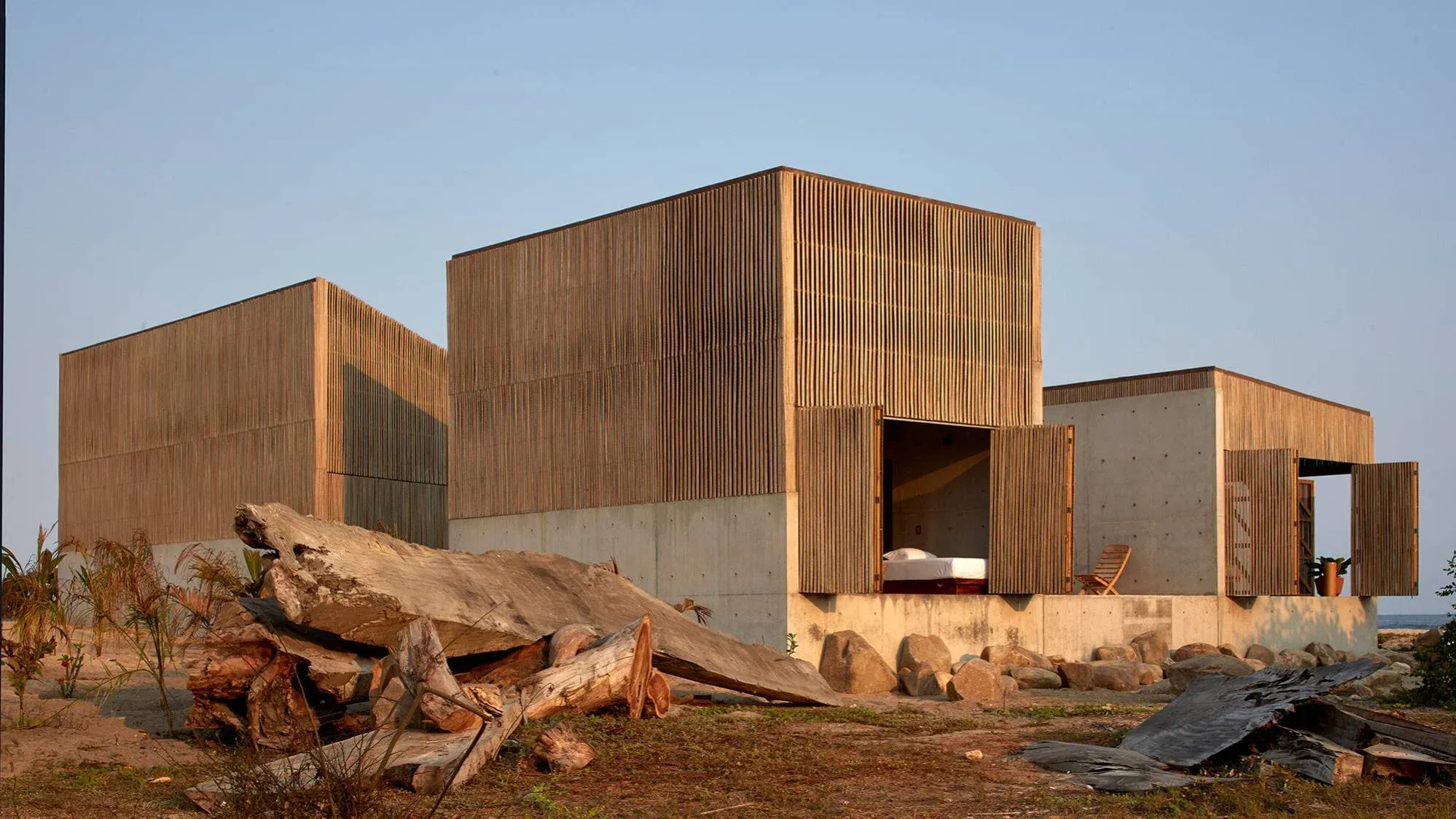Vernacular architecture draws its essence from the local, climate, materials, traditional techniques, and culture. It’s not about replicating an isolated aesthetic style, but about creating a dialogue with the environment, using local resources, and allowing each project to “breathe” with its surroundings.
At Caoba Hotels, we believe that every stay can be more than accommodation, it can be an immersion into both the ancestral and the contemporary. Here, we share how four of our properties embody distinct approaches to vernacular architecture, thoughtfully adapted to the 21st century.
1. Isla Fuerte EcoHouse: Colombian Caribbean. Cross Ventilation, Local Materials, and Climate Sensitivity.
At Isla Fuerte EcoHouse (Colombia), we find an exemplary case of how tropical vernacular architecture can merge seamlessly with principles of modern sustainability. The structure combines classic Caribbean elements, pitched roofs, open galleries, elevated platforms with passive ventilation systems and a layout designed to enhance the flow of sea breezes.
Local woods and natural materials are used throughout, minimizing technological intrusion. The forest bungalows are set back from the coastline to help preserve the local ecology, while the seafront terraces extend toward the water, blurring the boundary between built space and the marine landscape.
Beyond its architectural form, Isla Fuerte EcoHouse actively participates in local environmental and cultural projects, including mangrove restoration, artisan workshops, and underwater museums, so that the lodging not only reflects vernacular architecture but also becomes a catalyst for local regeneration.
Key Vernacular Features:
- Passive design: natural cross ventilation and pitched roofs for heat drainage.
- Elevation above coastal terrain to mitigate flooding and allow air circulation.
- Use of local, handcrafted materials.
- Integration with surrounding ecosystems: mangroves, native flora.
- Cultural relationship with the Zenú Indigenous community.

2. Casa Naila: Puerto Escondido, Mexico. Simplicity, Openness, and a Local Language.
Casa Naila (Puerto Escondido) stands as an outstanding example of how modern architecture can engage in dialogue with tropical vernacular traditions while respecting the local climate, culture, and materials.
The design embraces clean lines and open spaces that invite natural light and air circulation. Its use of wood and concrete gives the building a warm, organic character without compromising on comfort or contemporary elegance.
Within its “Vernacular” concept, Casa Naila positions itself as a tribute to the simplicity of Oaxacan culture, using a modular structure that seamlessly connects interior and exterior spaces.
Key Vernacular Features:
- Open spaces that merge indoors and outdoors, fostering permeability and connection.
- Local materials such as wood and concrete, crafted by regional artisans.
- Modular structure allowing flexibility and adaptation to the environment.
- Passive tropical design leveraging natural ventilation and lighting.

3. Estancia Rilán: Chiloé, Chile. A Window into Local Architectural Memory.
Located in Castro, Chiloé, Estancia Rilán revives the architectural identity of southern Chile, drawing inspiration from the region’s rural settlements and their deep connection with the island landscape. Designed by Ortúzar Gebauer Arquitectos, the hotel pays homage to Chiloé’s vernacular heritage while reimagining it for the present.
The construction employs local materials such as mañío wood and Cancagua stone, along with building techniques adapted to the rainy and windy southern climate. The ensemble is organized as a central house surrounded by auxiliary structures, evoking the traditional agrarian compounds characteristic of the archipelago.
The design captures the essence of Chiloé’s identity without falling into pastiche: contemporary forms meet local traditions, maintaining respect for natural views, solar orientation, ventilation, and rainwater harvesting.
Key Vernacular Features:
- Use of local materials: mañío wood and native Cancagua stone.
- Rainwater collection and greywater recycling systems.
- Clustered, rural layout reminiscent of island farmsteads.
- Large windows framing and connecting with the surrounding landscape.
- Reinterpretation of tradition through a functional, contemporary lens.

4. Lakeview Lodge: Atitlán, Guatemala. Mayan Tradition, Simplicity, and Connection with the Lake.
Perched on the hills of San Marcos La Laguna, Guatemala, Lakeview Lodge is a retreat where Mayan vernacular principles and sustainable techniques converge in an intimate lodge format.
Built with stone, wood, and adobe, and framed by panoramic windows that open to the surrounding landscape, the project prioritizes a fluid dialogue with nature, interiors that extend outward, and structures that seem to emerge organically from the lake’s topography.
Though modest in scale, a small cabin for two, every design decision heightens the sense of immersion, from sunrises over Lake Atitlán to the starlit nights reflected on its surface.
Key Vernacular Elements:
- Local materials: stone, adobe, and wood.
- Visual integration with the Lake Atitlán landscape.
- Simple architecture: compact volume with rich visual connections.
- Passive design optimizing natural light and ventilation in a temperate, highland climate.

These four lodgings demonstrate that vernacular architecture is not a rigid formula, but a design attitude, one that listens to place.
In each case, they combine:
- Respect for climate and microclimate: cross ventilation, orientation, appropriate roofing.
- Local materials and craftsmanship: wood, stone, adobe, and adapted traditional techniques.
- Indoor–outdoor connection: permeable spaces, open views, patios, and terraces.
- Sustainability and ecology: water harvesting, passive systems, and environmental commitment.
- Cultural identity: local references integrated into design, without falling into stereotypes.
For guests, these are not just places to stay, they are living experiences of place.
In each of these projects, vernacular architecture allows visitors to feel the geography, history, climate, and community as part of their stay.
Discover more of our vernacular architecture lodgings here.



